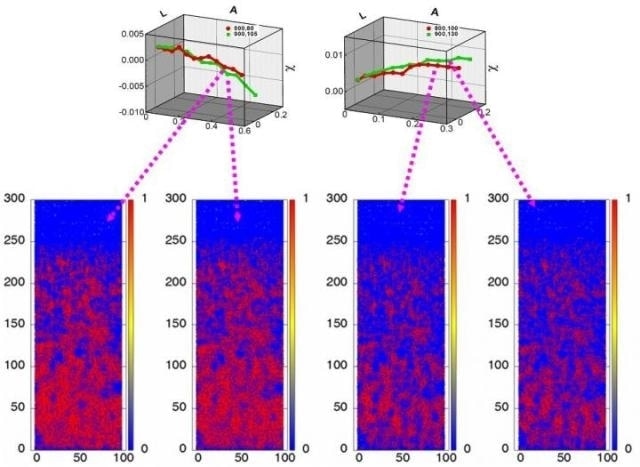Apr 13 2016
Scientists consider the dynamical responses of heterogeneous materials to be complicated, despite the fact that these responses regularly occur in engineering applications.
 Dynamical similarities for various shock strengths indicate similarities in transformation and dissipation processes of energy. (Credit: ©Science China Press)
Dynamical similarities for various shock strengths indicate similarities in transformation and dissipation processes of energy. (Credit: ©Science China Press)
Research conducted on this is challenging in physical modeling, analyzing scheme and simulation technique.
Profs. A. G. Xu, G. C. Zhang, Y. J. Ying and C. Wang, from Beijing, highlight that a sequence of coarse-grained models will help to probe the multi-scale behaviors. The slow-varying quantities, invariants, and similarity parameters are all separate variables that help to develop constitutive relations. After coarser-grained modeling, it is important to maintain the same dynamical behaviors of these physical quantities. Hidden underlying mechanisms can be revealed based on the analysis of complex fields and structures.
The four researchers concentrate mostly on slow variables, invariants and dynamical similarities present in the dynamical processes, executed in a wide variety of materials and at varied spatial-temporal scales under different loading conditions. The researchers focus on revealing the hidden underlying information by introducing new methods to identify, track, and analyze these fields and structures.
Fluid and solid models are used to describe the system, based on the loading strength corresponding to material strength. The fluid modeling is primarily based on the Discrete Boltzmann Method (DBM). DBM simulation not only presents the macroscopic behaviors that are mostly considered by the standard hydrodynamic models, but also presents the thermodynamic non-equilibrium (TNE) behaviors appropriate to the hydrodynamic ones. The TNE effects provide a better understanding about the complex non-equilibrium processes, and also function as the physical criteria required for kinetic processes. The various observations can help to enhance macroscopic modeling.
The material-point method (MPM) is adopted by the mesoscopic simulations based on a solid model for explaining the local non-uniformities in a convenient manner. Investigation is carried out for collapsing cavities and their impact on the global responses obtained from materials. It is possible to systematically probe and quantitatively determine the hidden statistical data present in structures with pressure, low or high temperature, stress, particle velocity, etc.
A group of dynamical similarities at different shocking conditions for a wide range of materials are revealed. The researchers assume that these similarities specify similarities existing in energy dissipation and transformation in the evolution processes of multi-scale structures, like eddy flowing, jetting, cavity collapsing, etc.
The microscopic critical behaviors are simulated by the molecular dynamics. These microscopic critical behaviors include structural phase transition, elasticity-plasticity transition, and transition between deformations in volume and shear. Studies concentrate on analyzing evolution laws and creation mechanisms of microscopic structures, such as new phase embryos, voids and dislocations, to name a few. These studies also examine the effect of microscopic structures on the material’s mechanical behaviors.
A set of general rapid searching schemes have been proposed to examine a wide range of spatial structures. The microscopic defects, under energy or external force, self-organize and form larger-scale structures. The system is inclined to follow the mechanism reducing the free energy.